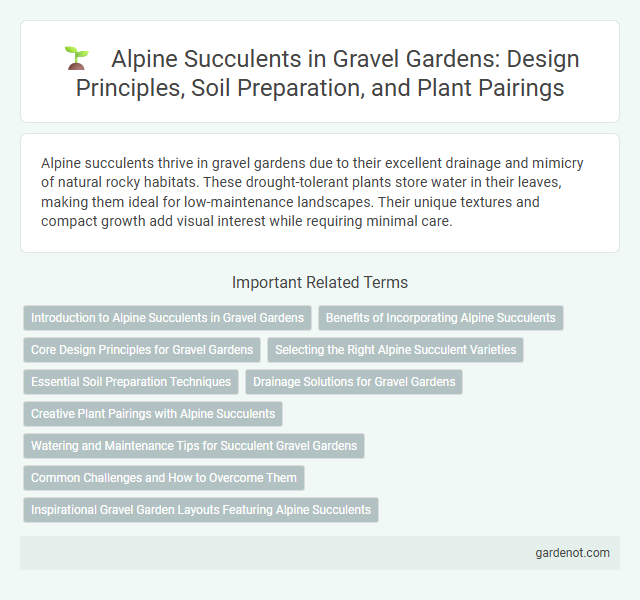Alpine succulents thrive in gravel gardens due to their excellent drainage and mimicry of natural rocky habitats. These drought-tolerant plants store water in their leaves, making them ideal for low-maintenance landscapes. Their unique textures and compact growth add visual interest while requiring minimal care.
Introduction to Alpine Succulents in Gravel Gardens
Alpine succulents are incredibly well-suited for gravel gardens due to their drought tolerance and ability to thrive in well-drained, rocky soil. These plants, including species like Sempervivum and Sedum, store water in their fleshy leaves, allowing them to survive harsh alpine conditions mimicked by gravel garden environments. Incorporating alpine succulents enhances the garden's texture and color variety while maintaining low maintenance and sustainability.
Benefits of Incorporating Alpine Succulents
Alpine succulents thrive in gravel gardens by conserving water through their thick, fleshy leaves, making them ideal for drought-resistant landscaping. Their compact size and slow growth minimize maintenance while enhancing visual interest with unique textures and vibrant colors. These plants improve soil stability and reduce erosion in rocky terrains, promoting a sustainable and low-maintenance garden environment.
Core Design Principles for Gravel Gardens
Alpine succulents thrive in gravel gardens due to their exceptional drought tolerance and preference for well-drained, rocky soils. Core design principles emphasize creating microclimates with varied textures and drainage patterns, ensuring optimal sun exposure and airflow to mimic alpine conditions. Incorporating these principles supports plant health and enhances the gravel garden's aesthetic appeal by blending form and function.
Selecting the Right Alpine Succulent Varieties
Choosing the right alpine succulent varieties for a gravel garden involves selecting species that thrive in well-drained, rocky soils and can withstand temperature fluctuations typical of alpine environments. Popular varieties such as Sempervivum, Sedum, and Jovibarba offer excellent drought resistance and low maintenance needs while providing diverse textures and colors. Prioritize succulents with compact growth habits and robust root systems to ensure optimal establishment and longevity in gravel garden settings.
Essential Soil Preparation Techniques
Alpine succulents thrive in well-drained, gritty soil that mimics their natural mountainous habitats. Essential soil preparation techniques include incorporating coarse sand, small gravel, and organic matter to enhance drainage and prevent root rot. Ensuring a slightly alkaline to neutral pH range between 6.5 and 7.5 supports optimal nutrient uptake for healthy growth.
Drainage Solutions for Gravel Gardens
Alpine succulents thrive in well-drained gravel gardens where water retention is minimal, preventing root rot and promoting healthy growth. Effective drainage solutions include using porous substrates like coarse sand and small gravel layers beneath planting areas to facilitate rapid water runoff. Installing a slight slope and incorporating drainage pipes or gravel trenches enhances water flow, ensuring alpine succulents receive optimal moisture balance in gravel garden environments.
Creative Plant Pairings with Alpine Succulents
Alpine succulents thrive in well-drained gravel gardens where their unique textures and compact forms create striking contrasts with drought-tolerant grasses and low-growing herbs like thyme or lavender. Combining these resilient plants enhances visual interest through varied leaf shapes and colors, while supporting biodiversity by attracting pollinators such as bees and butterflies. Strategic placement of alpine succulents with cushions of sedums and ornamental grasses improves soil aeration and moisture retention, ensuring a sustainable and low-maintenance garden design.
Watering and Maintenance Tips for Succulent Gravel Gardens
Alpine succulents thrive in well-drained gravel gardens with minimal watering, requiring only occasional deep irrigation during prolonged dry spells to prevent root rot. Maintenance involves removing debris and dead leaves regularly to promote airflow and prevent fungal infections, while applying a light layer of gravel mulch helps retain moisture and suppress weeds. Regularly inspect for pests such as mealybugs and aphids, treating infestations promptly with insecticidal soap or neem oil to maintain healthy succulent growth.
Common Challenges and How to Overcome Them
Alpine succulents in gravel gardens often face challenges like poor drainage and extreme temperature fluctuations, which can lead to root rot and frost damage. To overcome these issues, ensure well-draining soil mixed with coarse gravel and provide protective mulch or frost cloth during cold snaps. Regularly monitor moisture levels to prevent overwatering and promote healthy growth in harsh alpine conditions.
Inspirational Gravel Garden Layouts Featuring Alpine Succulents
Inspiring gravel garden layouts often incorporate alpine succulents such as Sempervivum and Sedum due to their exceptional drought tolerance and unique rosette formations. These plants thrive in well-drained, rocky soils, making them ideal for minimalist, low-maintenance designs that emphasize texture and color contrasts. Strategic placement of alpine succulents enhances the visual interest and sustainability of gravel gardens, creating dynamic, year-round appeal in arid or alpine conditions.
Alpine succulent Infographic

 gardenot.com
gardenot.com